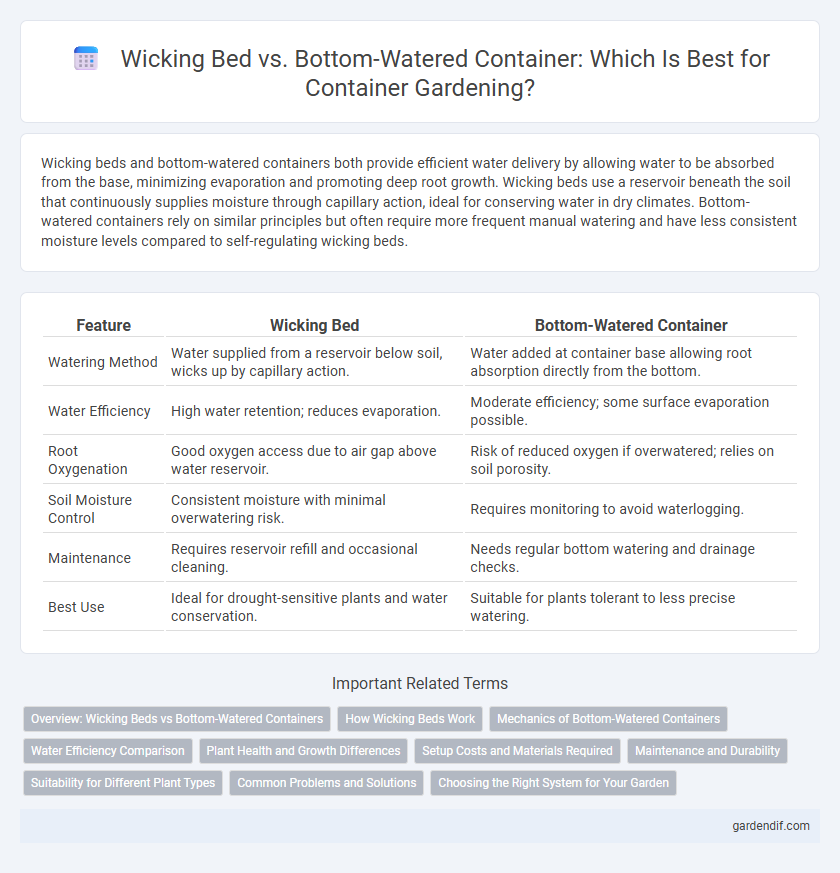
Wicking bed vs bottom-watered container Illustration
Wicking beds and bottom-watered containers both provide efficient water delivery by allowing water to be absorbed from the base, minimizing evaporation and promoting deep root growth. Wicking beds use a reservoir beneath the soil that continuously supplies moisture through capillary action, ideal for conserving water in dry climates. Bottom-watered containers rely on similar principles but often require more frequent manual watering and have less consistent moisture levels compared to self-regulating wicking beds.
Table of Comparison
| Feature | Wicking Bed | Bottom-Watered Container |
|---|---|---|
| Watering Method | Water supplied from a reservoir below soil, wicks up by capillary action. | Water added at container base allowing root absorption directly from the bottom. |
| Water Efficiency | High water retention; reduces evaporation. | Moderate efficiency; some surface evaporation possible. |
| Root Oxygenation | Good oxygen access due to air gap above water reservoir. | Risk of reduced oxygen if overwatered; relies on soil porosity. |
| Soil Moisture Control | Consistent moisture with minimal overwatering risk. | Requires monitoring to avoid waterlogging. |
| Maintenance | Requires reservoir refill and occasional cleaning. | Needs regular bottom watering and drainage checks. |
| Best Use | Ideal for drought-sensitive plants and water conservation. | Suitable for plants tolerant to less precise watering. |
Overview: Wicking Beds vs Bottom-Watered Containers
Wicking beds and bottom-watered containers both promote efficient water delivery directly to plant roots through capillary action, minimizing water waste and enhancing root health. Wicking beds typically feature a reservoir beneath a soil layer that passively supplies moisture upward, while bottom-watered containers utilize an elevated water source drawn up through a growing medium. Both systems reduce the frequency of watering and prevent surface evaporation, making them ideal for water-sensitive plants and sustainable gardening practices.
How Wicking Beds Work
Wicking beds work by drawing water from a reservoir at the bottom of the container through capillary action, which provides consistent moisture directly to plant roots. The water reservoir is separated from the soil by a wicking medium, often sand or gravel, ensuring soil stays moist without becoming waterlogged. This method reduces water usage and promotes healthier root growth by maintaining optimal hydration levels.
Mechanics of Bottom-Watered Containers
Bottom-watered containers use a reservoir system where water is supplied from the base, allowing moisture to wick upward through capillary action, ensuring even soil hydration and reducing surface evaporation. This mechanism supports healthier root development by maintaining consistent moisture levels and preventing waterlogging typically seen in top watering methods. In contrast to wicking beds, which rely on an integrated wicking fabric or medium, bottom-watered containers depend primarily on the physical separation of the growing medium and water source for efficient moisture transfer.
Water Efficiency Comparison
Wicking beds deliver superior water efficiency by utilizing capillary action to draw moisture directly to plant roots, significantly reducing evaporation and runoff compared to bottom-watered containers. Bottom-watered containers rely on gravity to draw water upward, often resulting in uneven moisture distribution and potential overwatering. Studies show wicking beds can reduce water usage by up to 50% while maintaining optimal soil moisture levels for healthy plant growth.
Plant Health and Growth Differences
Wicking beds provide consistent moisture by drawing water upward through a permeable soil layer, promoting healthier root development and reducing water stress, which enhances overall plant growth. Bottom-watered containers ensure roots absorb water directly at the base, but may cause uneven moisture distribution, potentially leading to root rot or nutrient deficiencies. Plants in wicking beds generally show improved vigor and resilience compared to those in bottom-watered systems due to optimized hydration and oxygen availability.
Setup Costs and Materials Required
Wicking beds typically require a water reservoir, a wick material such as fabric or rope, and a growing medium, resulting in moderate setup costs mainly due to the need for specialized components. Bottom-watered containers use a simpler design, often just a reservoir or tray beneath the soil, which can reduce initial expenses and material complexity. Both systems need durable containers, but wicking beds may involve higher material investment for effective water retention and delivery.
Maintenance and Durability
Wicking beds require minimal maintenance due to their self-watering design, which reduces the risk of overwatering and helps maintain consistent soil moisture, promoting healthy root growth. Bottom-watered containers also support efficient water use but may need more frequent monitoring to prevent root rot and ensure proper drainage. Wicking beds tend to be more durable as their design protects the reservoir from contamination and damage, whereas bottom-watered containers can experience wear and clogging in the watering system over time.
Suitability for Different Plant Types
Wicking beds are highly suitable for water-loving plants such as leafy greens, herbs, and shallow-rooted vegetables due to their consistent moisture supply from below. Bottom-watered containers work well for deep-rooted plants and fruiting crops like tomatoes and peppers, as they benefit from controlled watering and reduced surface evaporation. Both systems support healthy root development but cater to distinct plant moisture needs and root structures.
Common Problems and Solutions
Wicking beds often face issues such as salt buildup and uneven moisture distribution, which can be resolved by regular flushing and ensuring proper layering with a wicking medium. Bottom-watered containers may suffer from root rot and poor aeration, mitigated by using well-draining substrates and incorporating drainage holes. Both systems benefit from monitoring water levels and adjusting watering frequency to maintain optimal soil moisture and prevent plant stress.
Choosing the Right System for Your Garden
Wicking beds provide a self-watering system that delivers moisture directly to plant roots through capillary action, reducing water waste and promoting healthier growth in arid environments. Bottom-watered containers ensure consistent hydration by allowing roots to absorb water from a reservoir, minimizing surface evaporation and preventing overwatering. Selecting between wicking beds and bottom-watered containers depends on soil type, plant species, and water availability, optimizing garden efficiency and sustainability.
Wicking bed vs bottom-watered container Infographic

 gardendif.com
gardendif.com